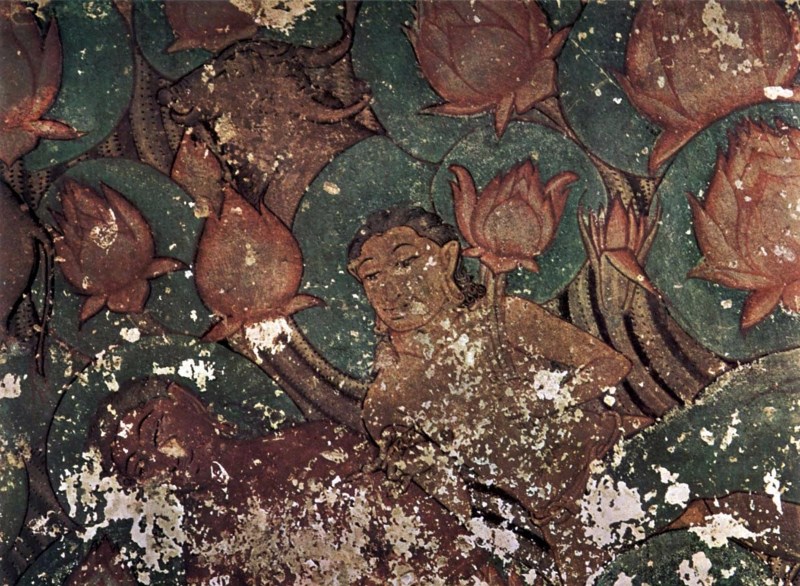It is common knowledge that paintings found on the walls or ceilings of caves are the earliest form of art the world can ever encounter, but what about the other paintings? As a matter of fact, there are millions of examples of ancient paintings that have been discovered across the globe that date back to thousands of years, and are possessed by all the major civilizations that ever flourished on this earth. Gallery of Gods presents to you one of the oldest pieces of finest artworks in the world:
The oldest of Indian paintings were found in caves, and this particular painting adorns the walls and ceiling of the Sittanavasal Cave in Tamil Nadu. These type of paintings were created with the help of plaster and then paint was applied on it applying the frescoe technique. An intriguing theory is that the original painting was done around the 1st Century BC, but then another artist drew over the authentic version.
This particular painting’s scenario is a depiction of Samava-sarvana, which is considered as a crucially significant scene in Jain religion. Apparently, Samava-sarvana is a remarkably noteworthy and gorgeous audience hall where Tirthankaras or the notably celebrated souls in Jainism, delivered religious sermons after attaining enlightenment or kevala-gnana. Various animals such as bulls, elephants, along with apsaras and gods gathered in this colossal hall to witness the magnificent scene.
While the rest are designs of flora. The apsaras or dancing women are drawn on the topmost corner of the columns along with lotuses. One of the artistic drawings comprise conjointly a drawing of a couple. These sketches of art have been administered with absolute brilliance. Furthermore, the southern pillar holds drawings of a queen and her king with an umbrella held over them.
Ancient India has been gigantically renowned for its unique tradition of painting on rocks and walls in natural caves portraying paintings from the Neolithic era, as well as the paintings that were done in the later ages. Initially the colours on Samava-sarvan were perhaps more radiant, but as time passed they have turned darker and have stained to quite some extent, but it’s a tremendous thing that they haven’t faded and survived for such a prolonged period, which in turn reflects on the impressively developed technique of art that the artist utilised on the prehistoric drawing.
The Sittanavasal Cave possesses walls of plaster with varying thickness, and the outermost layer is made up of sand which is quite rough, while the second layer has smoother sand. This leaves us quite astonished as it makes us realise that the artist has utilised a European style Fresco technique on them. The pigment is possibly a mild mixture of lime and some gum (the black pigment). Subsequently, the colour was carefully applied on the plaster, which adhered to it considerably well, as a result, it has persistently stood for a millennium.
Medieval artists were blessed with vital information about natural pigments, which is no longer available anywhere. The vital knowledge consisted of a crucial fact that bleaching of colours could be substantially prevented when blended with lime, and thus, would stand the test of time. The artists who have ever painted in Sittanvasal have applied a variety of colours including orange, white, blue, yellow, green, black and many more.
Unfortunately, as the ages passed, the preciously priceless paintings have been sabotaged, and shockingly a large extent of the damage was done by contemporary artists who greedily made various attempts to replicate the prehistoric paintings with the usage of tracing papers and re-drawing them, and in the procedure caused irreparable damage on those authentic pieces of fine traditional art. This is the major reason why today those paintings are hardly visible and lack in the exceptional glamour that they previously did.
Garba Griham
The Sittanavasal cave is not only renowned for its paintings but is also famous for many other artistic wonders. One of them includes a small chamber called Garba Griham, whose rear wall holds sculptures of three figures, which are known to be of Thirankaras and Acharya. Moreover, there’s a wheel carved on the ceiling that is the Dharma Chakra or the Wheel of Law.
Sittanavasal
Sittanavasal is a highly significant centre of the prehistoric Jain people, comprising a great number of other intriguing sculptures and monuments of Hindus and Jains.
Few of them include:
- Tamil inscriptions from the 9th-13th century AD that are located south of Arivar-Koil
- Between Eladipattam and Arivar-Koil, there is a marvellous monument called Navach Chunai, which is a tiny rock temple inside a lake.
- The walls of the cliff at the temple are embellished with sculpted Jain Thinkaras.
- And finally, at the western side of the hill, a shrine of deities with fine terracotta horses is present.

[Image Source : https://www.wondermondo.com/sittanavasal-cave/]